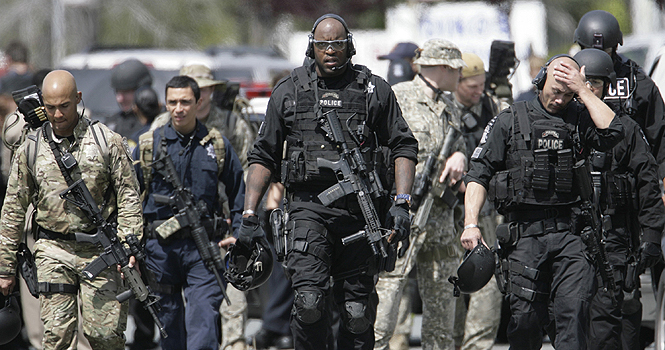What would Kent State do?
A SWAT team from the Oakland Police Department leaves the scene of a shooting at Oikos University on Edgewater Dr. in Oakland, California on Monday, April 2, 2012. Photo courtesy of MCT Campus.
April 2, 2012
Recent shootings at Chardon High School and even more recently at Oikos University in Oakland, Calif., Monday, are forcing some Kent State students and alumni to recall similar events in Kent State’s past.
Although what happened on May 4, 1970 is common knowledge to most Kent State students, few know about the murder of a Kent State custodial worker, the shooting of a student and rampage of a shooter that took place in December 1991 through February 1992.
According to recordpub.com, John T. Frazier was killed in the Kiva in December 1991, and a month and a half later Sarah Smith, then a Kent State graduate student, was shot in the chest near White Hall. She survived the injury but fear increased on campus.
Lea Barton, Yahoo! blogger, was a resident assistant in Johnson Hall the night the shooter, Mark Cunningham, was killed by Kent State police after firing at least five shots on campus.
“A member of the security staff came to my room and told me to get all residents into the hallways, to close their doors, and to do what was called a tornado drill — to act as if a tornado were coming,” Barton said in her blog ‘The other Kent State shootings: February 10, 1992’ published in 2007. “’Why?’ I asked, then heard a gunshot. Then screams.”
Even though Kent State Police Chief John Peach said the death of Frazier was the first homicide in campus history, Kent State has since taken action to protect students and faculty from an active shooter on campus.
Michquel Penn, community resource officer for the Kent State Police Department, said one of the programs the university provides is A.L.I.C.E. Alert, Lockdown, Information, Counter and Evacuation are sessions designed to give participants insight and response options when encountering an active shooter.
“It’s a class I really and truly believe in,” she said. “It includes lockdown, and it’s giving some other options that you may have in case you were ever put in that predicament.”
Penn said the class also teaches basic first aid in case a person is injured in a shooting and has to wait for EMS.
“[The class] is making a difference, and it’s sinking into people, and they are getting it,” she said.
She said so far more than 3,000 faculty, staff and students have taken the class.
FlashAlerts is another program Kent State provides for students. Penn said there are currently 40,309 individuals registered to receive FlashAlerts. Penn said if there ever was an active shooter on campus, students would be notified via FlashAlerts.
“You can’t predetermine what it’s going to say because every single one of those scenarios is going to be different,” Penn said. “It’s going to be concise only because we need to get it out as quick as we can to the KSU community, but at the same time we are going to be dealing with that situation.”
Penn said the message will give the pertinent information, such as the location of the shooter or what areas to avoid.
“As it progresses, that information is going to be put out as well so people are aware of what’s going on and are informed,” she said.
Penn said she highly recommends students take the A.L.I.C.E. program to prepare themselves and know what to do in case the events of 1991-1992 were repeated.
“Some people feel it’s not going to happen here or it can’t happen here, or they are getting ready to graduate so it doesn’t matter,” Penn said. “But the information we share in that class is information you can use after graduation. It can happen anywhere.”
Contact Caitlyn Callahan at [email protected].












